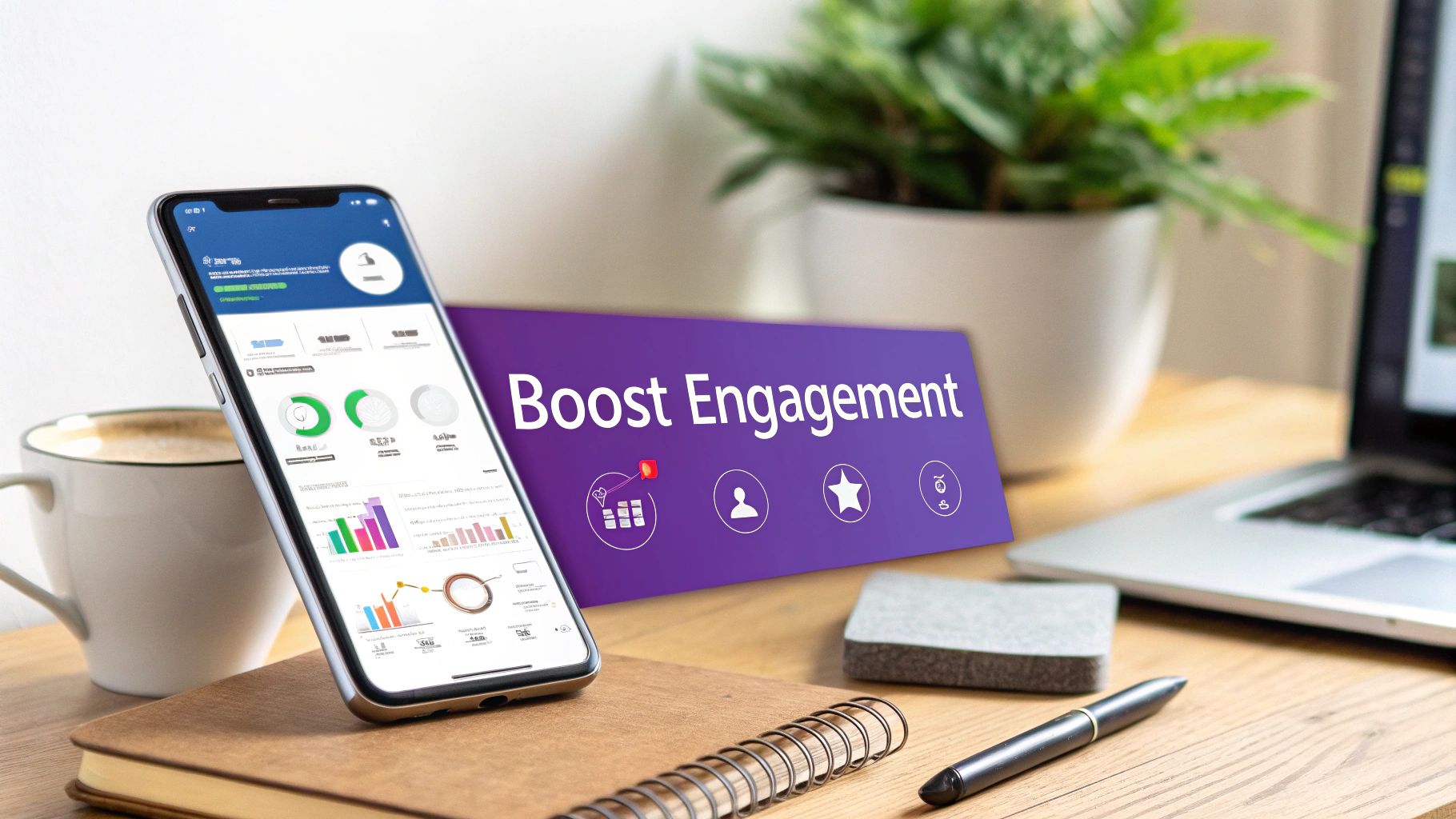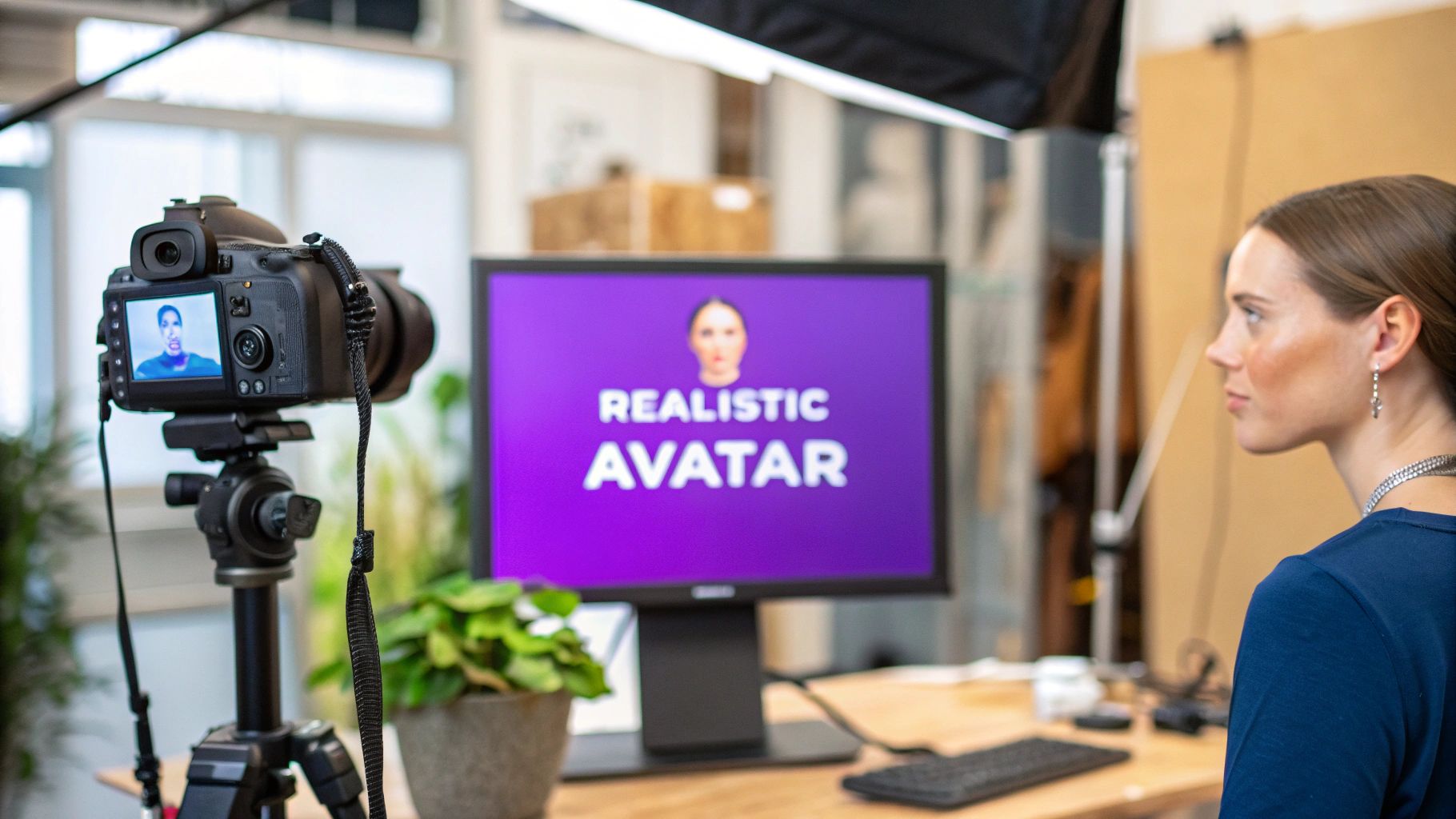7 Essential Professional Headshot Tips for 2025
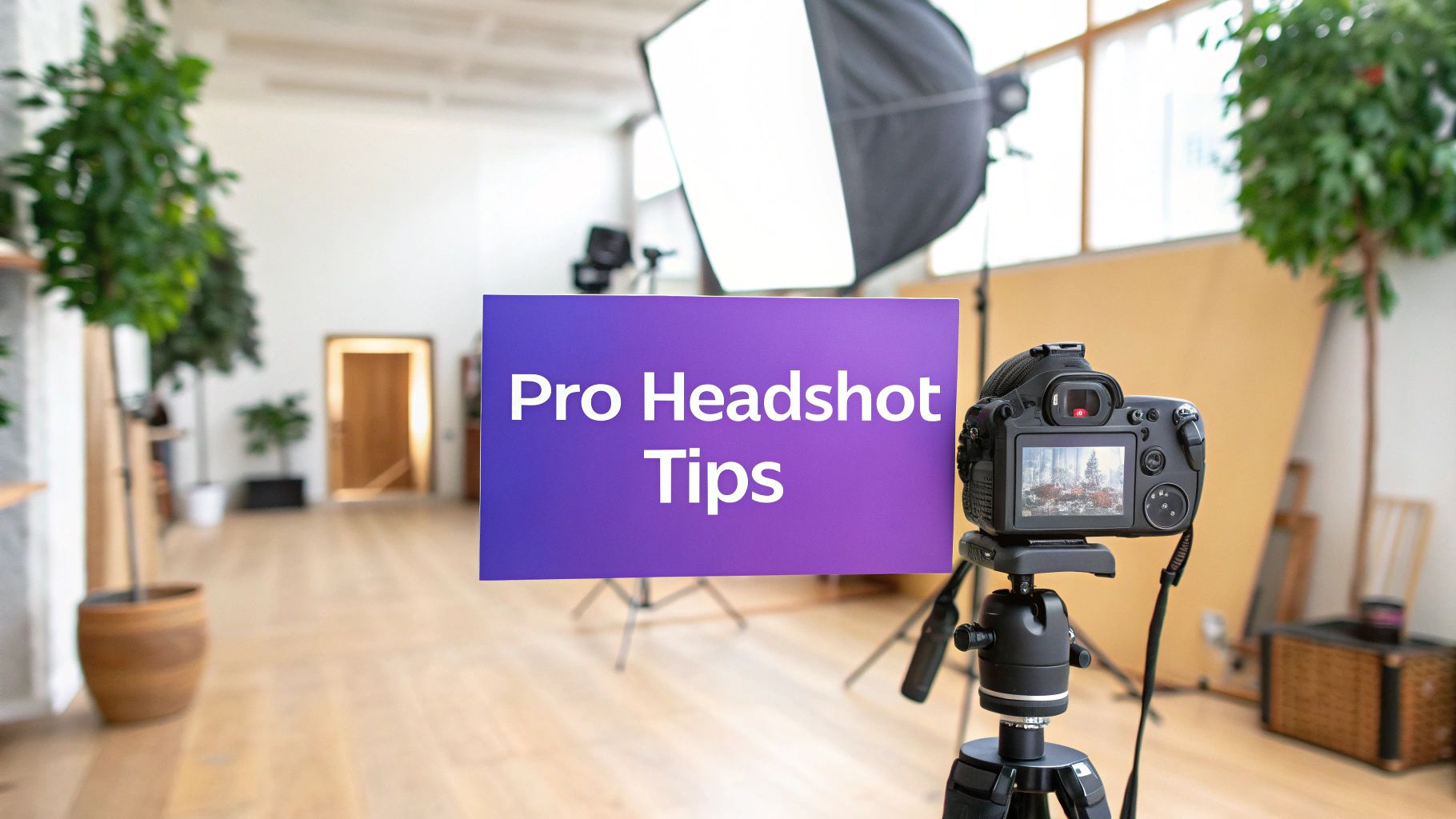
In today's hyper-competitive professional landscape, your headshot is far more than just a picture; it's a strategic career asset. It's often the very first impression you make on recruiters, potential clients, and future collaborators. A generic, outdated, or unprofessional photo can silently sabotage your opportunities, while a powerful, authentic headshot can open doors you didn't even know were there.
But what truly separates a forgettable snapshot from a compelling professional portrait? The difference lies in a handful of critical, often overlooked, details. This guide moves beyond basic advice to provide you with actionable, expert-level professional headshot tips. We will deconstruct the key elements that combine to create an image that not only looks great but actively works to build your personal brand and advance your career goals.
From the science of professional lighting and the psychology of body language to the nuances of retouching, these insights are designed for immediate impact. Whether you are preparing for a session with a photographer or refining an image with advanced tools, these seven core principles will ensure your next headshot is your most effective one yet. Get ready to learn how to capture a photo that commands attention and communicates confidence.
1. Invest in Professional Lighting
If there is one non-negotiable element that separates an amateur snapshot from a professional portrait, it is the quality of the lighting. Professional lighting is the foundational secret behind every great headshot, sculpting your features, eliminating distracting shadows, and adding a vibrant, life-like quality to the image. It controls the mood, highlights your best features, and ensures the final photo looks polished and high-end.
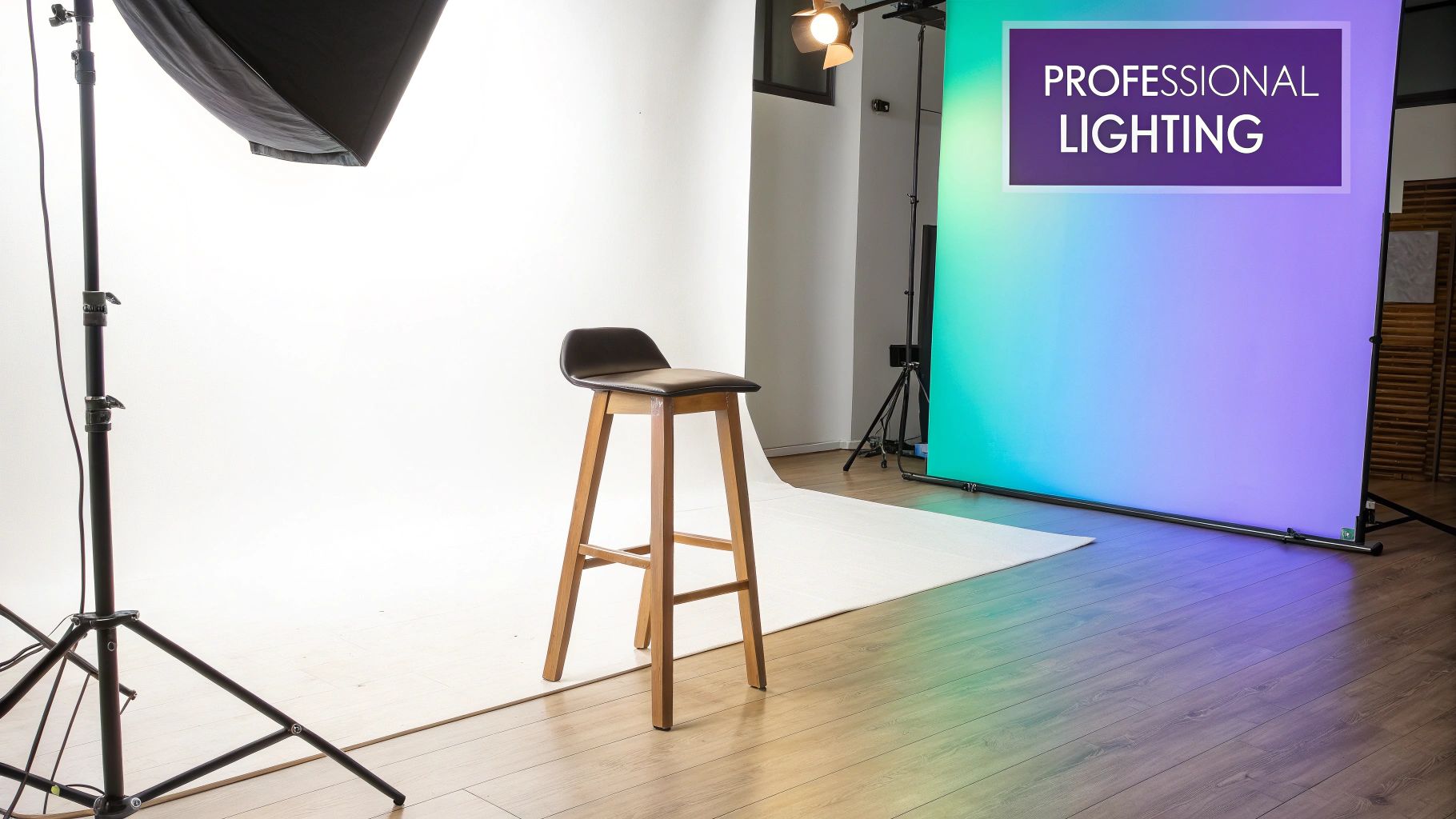
While hiring a photographer with a full studio setup is ideal, understanding the principles allows you to create or identify a quality setup. This knowledge is one of the most powerful professional headshot tips you can learn, empowering you to collaborate effectively with your photographer or even improve your own attempts.
Why It’s the Foundation of a Great Headshot
Proper lighting does more than just make you visible; it shapes how you are perceived. Harsh, direct lighting (like a camera's built-in flash or direct overhead sun) creates deep, unflattering shadows under the eyes and nose, which can make you appear tired or severe. Conversely, soft, diffused light minimizes blemishes and wrinkles, creating a smooth and appealing skin texture. Photographers like Peter Hurley have built entire careers around mastering specific lighting techniques that make subjects look confident and approachable.
A well-executed lighting plan creates dimension. By using multiple light sources, a photographer can separate you from the background, define your jawline, and add a sparkle to your eyes, often called a "catchlight." This gives the photo a three-dimensional feel that is engaging and dynamic.
Actionable Lighting Tips
Whether you are in a studio or using a DIY setup, apply these core lighting principles:
- Main Light Placement: Position your primary light source (the key light) at approximately a 45-degree angle to your face and slightly above eye level. This creates a gentle, flattering shadow pattern known as Rembrandt or loop lighting.
- Fill In Shadows: Use a secondary, less powerful light or a white reflector on the opposite side of your face. This "fills" in the shadows created by the key light, ensuring your features are clear without flattening the image.
- Natural Light is Your Friend: If you don't have studio lights, a large window is an excellent alternative. Face the window and hang a thin white sheet over it to diffuse the sunlight, creating a beautiful, soft-box effect.
- Avoid Overhead Lights: Steer clear of being directly under ceiling lights. This common mistake leads to "raccoon eyes," with dark shadows that obscure your expression.
2. Choose the Right Background
The background of your headshot is the stage upon which your professional persona is presented; it should complement you, not compete with you. A thoughtfully chosen background directs all attention to your face while subtly reinforcing your personal brand and industry context. It should be simple enough to avoid distraction but possess enough visual interest to prevent the photo from feeling flat or sterile.
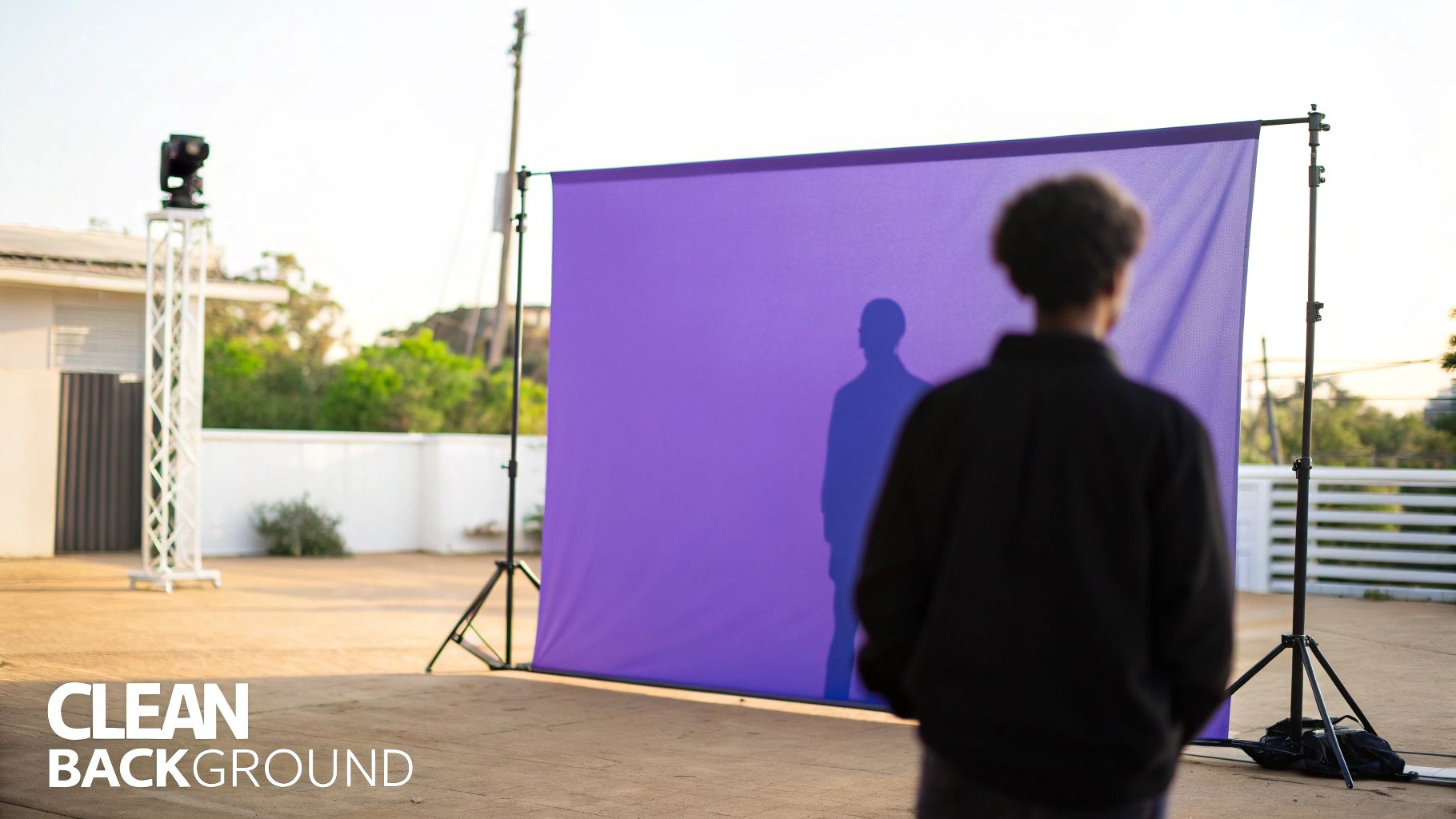
While it might seem like a minor detail, the background provides critical context about your profession and personality. This is one of the most impactful professional headshot tips because it allows you to control the narrative of your image before a viewer even analyzes your expression.
Why It’s the Foundation of a Great Headshot
The right background enhances the subject, while the wrong one can instantly undermine the photo’s credibility. A busy, cluttered, or overly bright background pulls the viewer's eye away from you, the focal point. Conversely, a clean, intentional background creates a polished look that signals professionalism and attention to detail, principles often highlighted in LinkedIn’s own headshot guidelines.
A well-selected backdrop also establishes mood and industry alignment. A solid gray or muted blue background conveys a corporate, serious tone suitable for lawyers or financial analysts. A softly blurred outdoor setting can make a life coach or real estate agent seem more approachable and grounded. The style popularized by photographers like Martin Schoeller, using simple yet textured backdrops, proves that the background is a powerful tool for creating a signature portrait style.
Actionable Background Tips
Consider these principles when selecting or creating your background:
- Create Separation: Ensure you are positioned at least three to four feet in front of the background. This allows the photographer to use a shallow depth of field, blurring the background slightly to make you "pop" as the clear subject.
- Consider Your Industry: Conservative fields like law, finance, and academia generally call for simple, solid backdrops (gray, white, or navy). Creative professionals in marketing or design have more freedom to use textured walls, pops of color, or interesting architectural elements.
- Complement, Don’t Clash: Choose background colors that complement your skin tone and outfit. Avoid colors that are too similar to what you're wearing, as this can cause you to blend in.
- Avoid Distractions: Steer clear of busy patterns, reflective surfaces, prominent logos (unless it's your company's), or any distracting elements that could draw attention away from your face.
3. Perfect Your Posture and Body Language
Your body language communicates volumes about your confidence, approachability, and professionalism long before a word is spoken. Mastering your posture for a headshot is about more than just standing up straight; it involves creating angles that flatter your shape, projecting positive energy, and ensuring your nonverbal cues align with your personal brand. Subtle adjustments to your shoulder position, head tilt, and expression can transform a good photo into a compelling one.

This is one of the most critical professional headshot tips because it puts you in control of the narrative. Body language experts like Amy Cuddy have shown how posture influences not only how others see us but also how we feel about ourselves. By adopting a "power pose," you can project an image of competence and leadership.
Why It’s the Foundation of a Great Headshot
The way you hold yourself directly impacts the viewer's perception of your professional persona. A slumped posture can read as uninspired or insecure, while an overly rigid stance may seem unapproachable. The goal is to find a balance that feels both confident and authentic. For example, CEOs often use a slight forward lean to appear engaged, while sales professionals might adopt more open body language to build trust.
Proper posing also adds dimension and dynamism to the photograph. Turning your body slightly away from the camera and bringing your face back towards it creates a more slimming and engaging line than a straight-on, passport-style photo. This technique, heavily endorsed by renowned photographers like Peter Hurley, helps define the jawline and creates a more interesting composition.
Actionable Posture Tips
Practice these techniques in a mirror before your session to find what feels most natural for you:
- Angle Your Body: Stand with your body angled about 30 to 45 degrees away from the camera, then turn your head to face the lens. This is a universally flattering pose that adds depth.
- Lean In Slightly: Lean forward from the waist. This simple move creates a sense of engagement and connection, making you appear more approachable and interested.
- Mind Your Chin: Push your chin slightly forward and down. This can feel awkward, but on camera, it effectively defines your jawline and prevents the appearance of a double chin.
- Shoulders Down and Back: Consciously roll your shoulders back and let them drop. This elongates your neck and projects an air of confidence and poise, correcting the natural tendency to hunch.
4. Nail Your Facial Expression and Eye Contact
Beyond lighting and wardrobe, your facial expression is the single most critical element that conveys personality and builds an immediate connection. It’s the human component that transforms a simple picture into a powerful communication tool, expressing confidence, approachability, and competence. Your eyes, in particular, must be sharp and engaging, acting as the focal point that draws the viewer in and holds their attention.
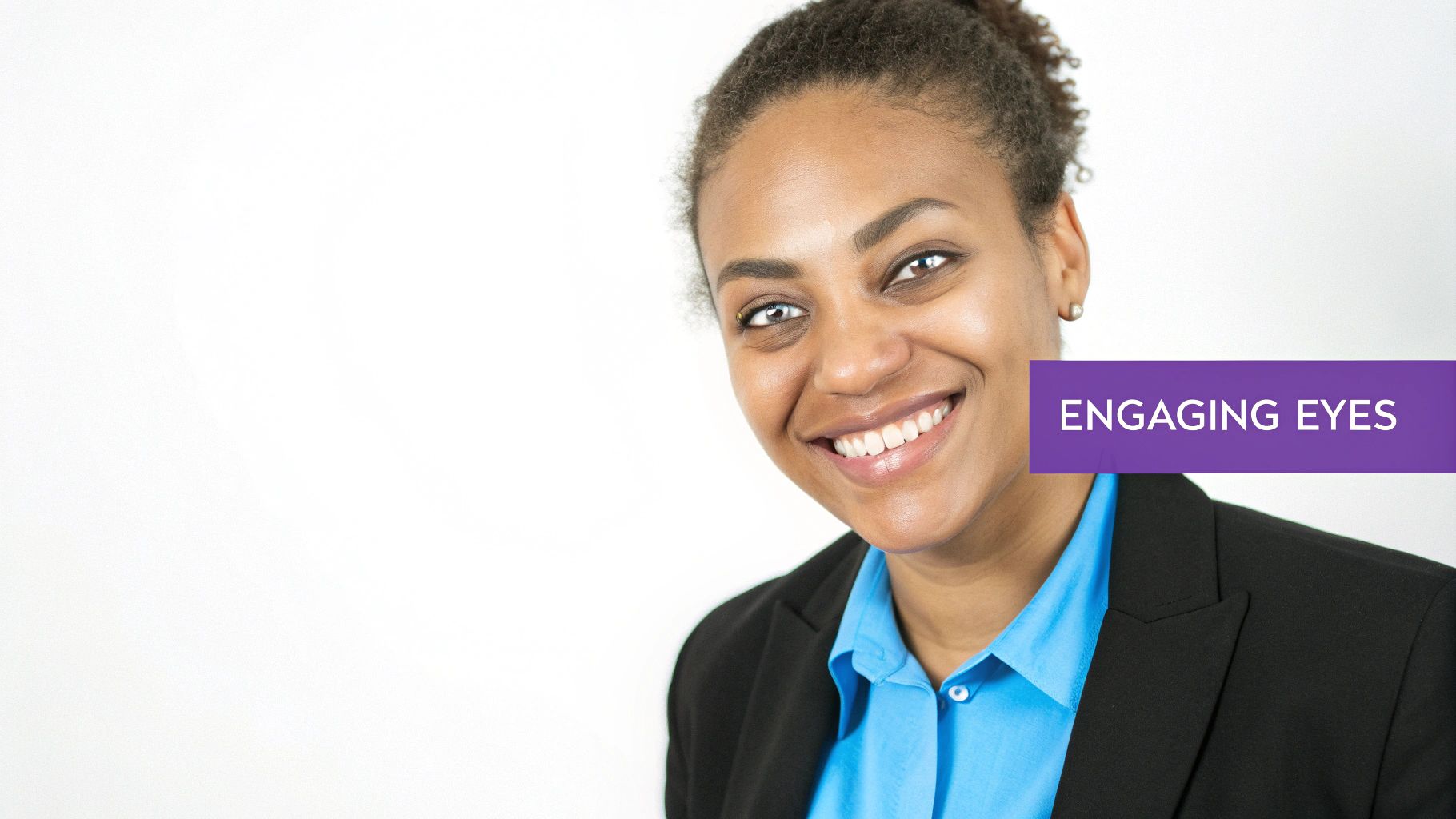
A genuine expression that aligns with your professional brand is the secret to a memorable headshot. This is one of the professional headshot tips that requires introspection: you must decide what you want your photo to say about you. Getting this right ensures your headshot works for you, building trust before you ever meet someone.
Why It’s the Heart of Your Headshot
Your expression tells a story. A blank or forced smile can make you seem disingenuous or uncomfortable, while an authentic expression can instantly establish rapport. Photographers like Peter Hurley have championed techniques such as the "squinch" (a slight squinting of the lower eyelids) specifically to make subjects appear more confident and engaged. It's about looking through the lens, not just at it.
The right expression is also industry-specific. For example, a therapist might aim for a warm, empathetic look to build trust, while a financial advisor would project confidence and reliability. A creative professional can use a more expressive, personality-driven look to showcase their unique brand. The goal is to close the gap between your digital presence and your real-world persona.
Actionable Expression Tips
Achieving a natural look on command can be challenging. Use these techniques to master your expression:
- Practice in the Mirror: Before your session, practice different expressions. Identify what a confident, approachable, and happy version of you looks like. This helps build muscle memory.
- Think of a Happy Memory: To create a genuine Duchenne smile (one that involves the eyes), think of something or someone that truly makes you laugh or feel joy. This authenticity cannot be faked.
- Focus on the Eyes: Even in a more serious shot, your eyes should convey engagement. Try to "smile with your eyes." A slight squinch can add an instant dose of confidence and focus.
- Take Frequent Breaks: Holding a smile can lead to facial fatigue and a strained look. Don't be afraid to relax your face completely between shots to keep your expression fresh and natural.
5. Dress Appropriately for Your Industry
Your wardrobe selection is a powerful, non-verbal communication tool in your headshot. The right outfit does more than just make you look good; it instantly signals your industry, level of professionalism, and personal brand. Dressing appropriately builds trust and credibility by aligning your visual identity with the expectations of your target audience, whether they are potential clients, employers, or collaborators.
This advice is one of the most crucial professional headshot tips because it ensures your photo accurately represents your professional context. A lawyer in a sharp business suit conveys authority and tradition, while a graphic designer in a smart casual outfit suggests creativity and approachability. Your clothing choice frames how you are perceived before anyone reads your bio.
Why It’s Key for Professional Context
Your attire should match the "uniform" of your field. Think about what a top performer in your industry would wear to an important meeting. For a corporate finance professional, this likely means a tailored suit. For a tech startup founder, it might be a high-quality branded polo or a crisp button-down shirt without a tie. Getting this wrong can create a disconnect. An overly casual look in a formal industry can undermine your seriousness, while an overly formal look in a creative field can make you seem rigid.
The goal is to look like an aspirational version of yourself within your professional role. Your clothing should feel authentic to you while also meeting industry norms. This balance shows that you understand your professional environment and are a confident, established member of it.
Actionable Wardrobe Tips
Whether you are a seasoned executive or a budding entrepreneur, use these guidelines to select the perfect outfit:
- Choose Solid Colors: Stick to solid jewel tones or deep neutrals like navy, gray, or forest green. These colors are universally flattering and keep the focus on your face, unlike busy patterns or bright neons which can be distracting.
- Prioritize Fit: Poorly fitting clothes can make you look sloppy. Ensure your jacket, shirt, or blouse fits well across the shoulders and chest. If necessary, invest in minor tailoring; it makes a significant difference.
- Bring Multiple Options: Don't limit yourself to one look. Bring at least two or three different tops or jackets to the photoshoot. This gives you and the photographer variety to choose from, ensuring you get the perfect shot.
- Mind the Neckline: V-necks and collared shirts are generally flattering as they elongate the neck. Avoid turtlenecks that can crowd your face or plunging necklines that may appear unprofessional.
6. Focus on Technical Quality and Sharpness
Beyond posing and lighting, the technical execution of a photograph is what cements its professional status. Technical quality encompasses everything from the sharpness of the image to the correct exposure and color balance. It's the digital craftsmanship that ensures your headshot looks crisp, clean, and polished, whether viewed on a tiny mobile screen or a large printed banner. A technically flawless image communicates precision and attention to detail, traits that reflect well on you professionally.
This focus on technicals is one of the most vital professional headshot tips because it ensures versatility. A high-resolution, perfectly sharp photo can be cropped, resized, and used across countless platforms without losing its impact. From a corporate website to a LinkedIn profile or an actor’s 8x10 print, technical integrity is non-negotiable.
Why It’s the Mark of a True Professional
A blurry or poorly exposed photo immediately signals amateur work. The human eye is naturally drawn to the eyes in a portrait, and if they are not tack sharp, the entire image feels disconnected and unprofessional. A professional photographer understands the precise camera settings needed to achieve this sharpness while artfully blurring the background to make you stand out. This shallow depth of field, often achieved with an aperture like f/2.8 or f/4, isolates you as the subject.
Furthermore, shooting in a high-quality format like RAW gives the photographer maximum flexibility in post-production. It allows for fine-tuning brightness, contrast, and color to perfection without degrading the image quality. This meticulous process ensures the final product is not just a picture, but a high-fidelity representation of you.
Actionable Technical Tips
To ensure your headshot meets professional standards, focus on these technical details:
- Prioritize Eye Focus: The camera’s focus point must be locked on the eye closest to the lens. This is the single most important rule for a compelling portrait. Taking multiple shots in a burst can help guarantee at least one is perfectly sharp.
- Use a Tripod: Even the steadiest hand can introduce motion blur. A tripod eliminates camera shake, guaranteeing the sharpest possible image, especially in lower light conditions.
- Shoot in RAW Format: This file format captures all the image data from the camera's sensor, unlike JPEGs which compress and discard information. RAW files provide much more latitude for editing and perfecting the final image.
- Control Your ISO: Keep the ISO setting as low as possible (typically 100-400) to minimize digital "noise" or graininess. This results in a cleaner, smoother image with better detail.
7. Master the Art of Retouching and Post-Processing
A professional headshot doesn't end when the camera shutter clicks; the final magic happens during post-processing. Expert retouching is the critical step that refines a great photograph into an exceptional one, polishing the final image while preserving your natural authenticity. It addresses minor distractions, enhances colors, and ensures the photo presents the most professional and confident version of yourself.
The goal of post-processing isn't to change who you are, but to remove temporary imperfections that detract from your professional presence. Understanding what skilled retouching, often done with tools like Adobe Photoshop, can achieve is one of the most vital professional headshot tips for ensuring a high-quality, polished final product.
Why It’s the Foundation of a Great Headshot
Professional retouching bridges the gap between a good photo and a stellar one. It corrects subtle issues that the camera might capture unflatteringly, such as stray hairs, minor skin blemishes, or uneven lighting that wasn't fully corrected on set. A skilled retoucher ensures color accuracy, making sure your skin tones and clothing colors appear true to life.
More importantly, tasteful editing guides the viewer's focus. By subtly brightening the eyes and softening distracting background elements, the retoucher ensures your expression remains the focal point of the image. For professionals like corporate executives or real estate agents, this level of polish conveys attention to detail and a high standard of quality, directly reflecting on their personal brand.
Actionable Retouching Tips
Whether you are working with a photographer or editing an image yourself, aim for subtlety and authenticity:
- Focus on Temporary Imperfections: The key is to remove temporary issues like a pimple, a piece of lint on your jacket, or under-eye circles from a poor night's sleep. Avoid altering permanent features like scars or moles unless you specifically wish to.
- Maintain Skin Texture: One of the biggest mistakes is over-smoothing the skin, which creates a fake, "plastic" look. Professional retouching techniques preserve natural skin texture while minimizing blemishes.
- Enhance the Eyes: The eyes are the most expressive part of a headshot. A touch of brightening to the iris and a slight sharpening can make them pop, creating a more engaging and confident appearance.
- Check Color and Contrast: Ensure the overall image has a balanced tone. Adjusting the white balance, contrast, and saturation can make the photo feel more vibrant and lifelike without looking artificial. The result should look like you on your best day.
7 Essential Professional Headshot Tips Comparison
| Aspect | Invest in Professional Lighting | Choose the Right Background | Perfect Your Posture and Body Language | Nail Your Facial Expression and Eye Contact | Dress Appropriately for Your Industry | Focus on Technical Quality and Sharpness | Master the Art of Retouching and Post-Processing |
|---|---|---|---|---|---|---|---|
| Implementation Complexity 🔄 | High: requires technical setup & multiple lights | Medium: selecting & positioning background | Medium: practicing natural, confident poses | Medium: maintaining authentic expressions | Medium: selecting and fitting appropriate attire | High: pro equipment & expertise needed | High: skilled, detailed post-processing needed |
| Resource Requirements ⚡ | High: costly lighting equipment | Low-Medium: backgrounds & minor setup | Low: mainly practice and guidance | Low-Medium: coaching and self-awareness | Low-Medium: wardrobe investment & styling advice | High: professional camera gear and storage | Medium-High: software and retouching expertise |
| Expected Outcomes 📊 | ⭐⭐⭐⭐⭐: Dramatically improved image quality | ⭐⭐⭐⭐: Enhanced focus & background professionalism | ⭐⭐⭐⭐: Confident, flattering presentation | ⭐⭐⭐⭐⭐: Engaging, memorable expressions | ⭐⭐⭐⭐: Builds credibility and brand alignment | ⭐⭐⭐⭐⭐: Crisp, professional appearance across media | ⭐⭐⭐⭐: Polished, natural enhancement of features |
| Ideal Use Cases 💡 | Studio shoots, formal portraits | All headshots needing brand consistency | Leadership, sales, client-facing roles | Roles needing trust, approachability, personality | Corporate, creative, healthcare, tech professionals | Professional headshots for print and digital use | Final image polishing for marketing and portfolios |
| Key Advantages ⭐ | Eliminates shadows, adds depth & dimension | Focus attention, reinforce brand image | Projects confidence, creates engaging angles | Creates connection, conveys authenticity | Communicates professionalism, enhances natural look | Ensures perfect focus, exposure & media flexibility | Removes imperfections subtly, enhances natural look |
Transform Your Headshot into Your Greatest Asset
You have now moved far beyond the basic advice and into the realm of strategic self-presentation. This comprehensive guide has equipped you with a complete toolkit of actionable professional headshot tips, transforming what can be a daunting task into a manageable and impactful process. We've explored how each distinct element, from the technical to the personal, synergizes to create a powerful first impression.
A truly effective headshot is a testament to your professional story. It’s not just a picture; it's a carefully constructed narrative that communicates competence, approachability, and authority before you ever speak a word. By implementing these strategies, you are taking direct control of that narrative.
From Good to Unforgettable: Your Key Takeaways
Let's distill the core principles that will elevate your image from merely acceptable to genuinely unforgettable:
- Technical Excellence is Non-Negotiable: Issues with lighting, focus, or background are immediate signals of a lack of attention to detail. Investing in professional lighting and ensuring crystal-clear sharpness are foundational steps that build credibility.
- Authenticity Wins: The most compelling headshots capture your genuine personality. Your expression, posture, and even your wardrobe should align with your industry and personal brand, creating an authentic connection with the viewer. Avoid stiff poses or forced smiles; aim for a look that is both professional and genuinely you.
- The Details Define the Outcome: Subtle adjustments in posture, a thoughtful choice of background color, and tasteful post-processing are what separate a good headshot from a great one. These details collectively enhance your image, ensuring you look polished, confident, and ready for the next opportunity.
Your Actionable Next Steps
Your journey to a better headshot doesn't end here. It begins with action. Start by evaluating your current headshot against the tips outlined in this article. Identify the single biggest area for improvement, whether it's updating your wardrobe to better reflect your career goals or finding a location with better natural light.
Consider creating a simple "mood board" with examples of headshots you admire within your field. This will help you articulate exactly what you want to achieve when you step in front of the camera, whether you're using a professional photographer or leveraging advanced technology. Remember, a standout headshot is an investment in your personal brand, a digital asset that works for you 24/7, opening doors to new connections and career-defining opportunities. By mastering these professional headshot tips, you ensure your digital handshake is firm, confident, and memorable.
Ready to bypass the photoshoot and get a portfolio of stunning, studio-quality images in minutes? MakerBox uses advanced AI to transform your casual selfies into dozens of polished, professional headshots perfect for LinkedIn, your website, and more. Elevate your entire professional brand today at MakerBox.


